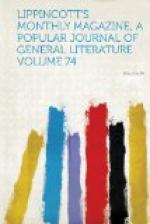The instruction of deaf mutes in articulate speech has of late years attracted considerable attention in both Europe and America. In some of the European schools, in the Clark Institute at Northampton, Massachusetts, and in a few of our State institutions it is brought to great perfection. There are also special schools for this system of teaching in most of our large cities. The majority of pupils in these schools converse with ease, and understand readily what is said to them by means of the motion of the lips. The Clark Institute at Northampton, already referred to, under the conduct of Miss Harriet Rogers, is the largest and most widely known of the schools for this special method of instruction in this country. This is not a State institution, but one endowed by the munificence of a private gentleman, and consequently subject to none of the restrictions imposed on the public institutions. Of course, only the most promising pupils are sent there, and from these a careful selection is made, by which means the highest possible success is ensured. Some of the State institutions, however, burdened as they are with a large and unassorted mass of pupils, have made most encouraging progress in this direction. Of these, one of the most successful is the Illinois institution. In its last published report the correspondence between the principal and the parents of those pupils who have been taught by this method is given, showing the utmost satisfaction at the progress made and results attained.
Deaf mutes are divided into two classes—viz., entire mutes and semi-mutes. The first comprises those who either have been born deaf or have become so at so early an age as to have retained no knowledge of articulate speech. The second class embraces those who have lost their hearing after attaining such an age as still to be able to talk. Speech is more easily and perfectly learned if the pupil has learned to read before the loss of hearing. A knowledge of the sounds and powers of the letters enables him to acquire the pronunciation of new words with much greater facility than would be otherwise possible, giving him a foundation on which to build his acquisition of spoken language. To this last class, semi-mutes, articulation is invaluable, enabling them to pursue their education with less difficulty, and also to retain their power of communication with the outside world. In regard to entire mutes, the utility of the accomplishment is seriously questioned by some experienced educators. The fact must be admitted that, while a much larger number of entire mutes can be taught to converse intelligently and agreeably than would be imagined by those unacquainted with the results obtained, the great mass of the deaf and dumb must still be instructed wholly by means of written language. In most instances, to ensure success, instruction should be begun at a very much earlier age than it is possible to receive them into school, and constantly practiced by all who hold communication




